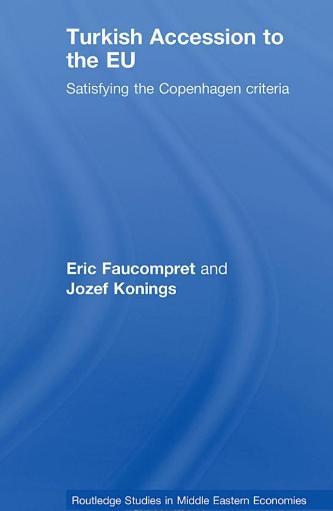Turkish Accession to the EU - Satisfying the Copenhagen Criteria
Eric FAUCOMPRET, Jozef KONINGS
Availability: Out of stock - available in 15 open days
- Categories: Turkey
- Publisher: ROUTLEDGE
- Collection: Routledge Studies in Middle Eastern Economies
- ISBN: 9780415457132
- Publication Date: 23/05/2008
- Binding: Hardback
- Number of pages: 222
Summary
Is Turkey on the way to meet the economic Copenhagen criteria?
The enlargement process that the European Union faced the last decade stirred the debate again about the role Turkey has to play and whether or not Turkey should be part of the European Union. While the enlargement with the Central and East European countries of the former Soviet Union was a logical process, given the strong trade relationships and the political and historical context of these countries, the potential enlargement with Turkey is much more complex and controversial.
The main innovation of the present study is that it unravels the complexity of the Turkish case by approaching the problem from different angles in a comprehensive way. In particular, by tuning in on the historic, political and economic processes, new insights are obtained about the feasibility of Turkish accession to the EU. By combining lessons from the existing literature, the use of new data and the analysis of the political economic processes, a new perspective on the enlargement question – with the key Copenhagen criteria used as a corner stone - is offered.
Table of contents
Introduction
1. Short survey of the history of Turkey
1.1 The end of the Ottoman Empire
1.2 The establishment of modern Turkey
1.3 The Republicans
1.4 The Democrats 1.5 The second republic
1.6 The sixties
1.7 The 1970 coup
1.8 The 1980 coup
1.9 Turgut Özal
1.10 The bloodless 1997 coup
1.11 Erdogan
1.12 Conclusion
2. History of Turkey-EU relations
2.1 The cold war
2.2 The European Coal and Steel Community and the European Defense Community
2.3 The European Economic Community
2.4 The EEC in the sixties and seventies
2.5 The EC in the eighties
2.6 The EC in the nineties: the Maastricht treaty
2.7 The EU in the nineties: the enlargement with the CEEC
2.8 Turkey and the EU in the nineties
2.9 The EU in the nineties: Agenda 2000
2.10 The EU in the new millennium: Nice
2.11 The Copenhagen European Council
2.12 The ill-fated constitutional treaty
2.13 Negotiations at last
2.14 Conclusion
3. The Copenhagen economic criteria
3.1 A functioning market economy
3.1.1 Economic Policy Essentials
3.1.2 GDP per capita
3.1.3 Human Development
3.1.4 Income inequality
3.1.5 Global Competitiveness
3.1.6 Conclusion
3.2 Macroeconomic stability
3.2.1 Economic growth
3.2.2 Unemployment rate
3.2.3 Inflation
3.2.4 Balance of Payments
3.2.5 Conclusion
3.3. Free interplay of market forces
3.3.1 Free market entry and exit
3.3.2 Adequate legal system
3.3.3 Sufficiently developed financial sector
3.3.4 Conclusion
3.4 The capacity to cope with competitive pressure and market forces within the Union
3.4.1 Sufficient investment in human capital
3.4.2 Sufficient investment in physical capital
3.4.3 Positive physical infrastructure related factors
3.4.5 Structural transformation of the economy
3.4.6 State influence on competitiveness and enterprise restructuring
3.4.7 Growing trade integration of goods and services with the EU
3.4.8 General picture of EU-Turkey trade relations with respect to goods
3.4.9 Intra-industry Specialization and Revealed Comparative Advantages
3.4.10 Trade integration with respect to services
3.4.11 Conclusion
3.5 The ability to take on the obligations of membership, including the aims of the economic and monetary union
3.5.1 The ability to take on the obligations of membership, including the administrative capacity to effectively apply and implement the Acquis Communautaire
3.5.2 The free movement of goods
3.5.3 The customs union
3.5.4 Anti dumping measures
3.5.5 Technical and administrative barriers
3.5.6 The freedom to establish and to supply services
3.5.7 Competition and state aid
3.5.8 Employment and Social Policy
3.5.9 Freedom of movement of workers
3.5.10 Historical overview
3.5.11 EU point of view
3.5.12 How many Turkish citizens would emigrate?
3.5.13 Agriculture
3.5.14 Turkish farming
3.5.15 The EU Common Agricultural Policy (CAP)
3.5.16 Turkey and the CAP
3.5.16 Regional policy and coordination of structural instruments
3.5.17 The EU Regional Policy
3.5.18 Regional inequalities in Turkey
3.5.19 Budgetary impact
3.5.20 Financial and budgetary provisions
3.5.21 Foreign, security and defence policy
3.5.22 The Common Foreign and Security Policy (CFSP)
3.5.23 Turkey’s foreign policy
3.5.24 Turkey and EU Common Foreign and Security Policy (CFSP)
3.5.25 Justice, freedom and security
3.5.26 Growing Acquis Communautaire
3.5.27 Problems for Turkey
3.5.28 Turkey and the Area of Justice, Freedom and Security
3.5.29 Education and culture
3.5.30 Conclusion
3.5.31 The Copenhagen economic criteria: general conclusions
4. The Copenhagen political criteria
4.1 Democracy and the rule of law
4.2 Civil-military relations
4.3 Judicial system 4.4 Anti-corruption measures
4.5 Human rights and the protection of minorities
4.6 Observance of human rights law
4.7 Civil and political rights
4.8 Summary of conclusions
4.9 Freedom of religion
4.10 Economic and Social Rights
4.11 Minority rights, cultural rights and the protection of minorities
4.12 Conclusions
5. Other conditions
5.1 Good neighbourly relations
5.2 Iraq, Syria and Armenia
5.3 Greece
5.4 The Cyprus file
5.5 Absorption Capacity of the EU
5.6 Conclusion
6. Final Conclusion
6.1 Turkey, the EU and the Copenhagen criteria
6.2 Benefits and burdens
6.3 Benefits and burdens for the EU
6.4 Benefits and burdens for Turkey References
